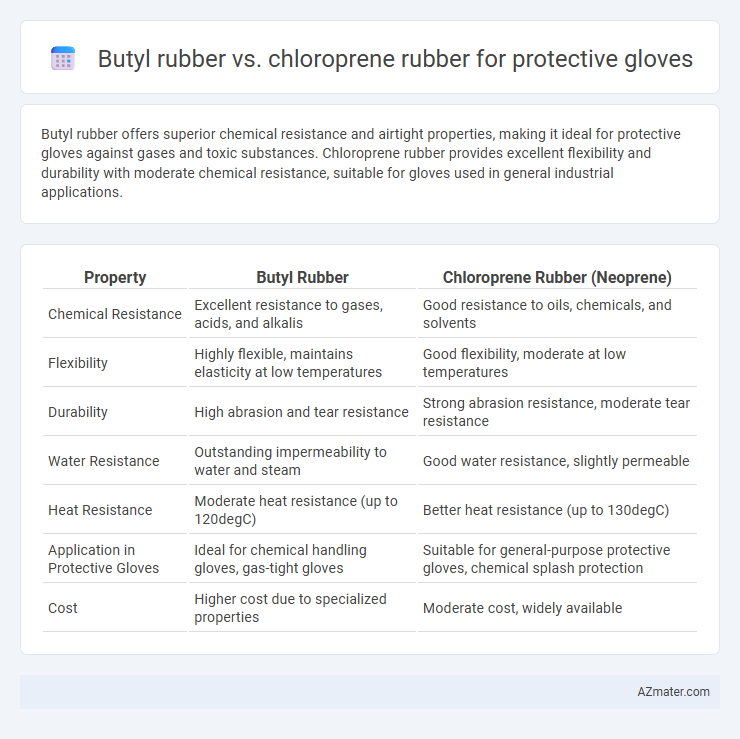Butyl rubber offers superior chemical resistance and airtight properties, making it ideal for protective gloves against gases and toxic substances. Chloroprene rubber provides excellent flexibility and durability with moderate chemical resistance, suitable for gloves used in general industrial applications.
Table of Comparison
| Property | Butyl Rubber | Chloroprene Rubber (Neoprene) |
|---|---|---|
| Chemical Resistance | Excellent resistance to gases, acids, and alkalis | Good resistance to oils, chemicals, and solvents |
| Flexibility | Highly flexible, maintains elasticity at low temperatures | Good flexibility, moderate at low temperatures |
| Durability | High abrasion and tear resistance | Strong abrasion resistance, moderate tear resistance |
| Water Resistance | Outstanding impermeability to water and steam | Good water resistance, slightly permeable |
| Heat Resistance | Moderate heat resistance (up to 120degC) | Better heat resistance (up to 130degC) |
| Application in Protective Gloves | Ideal for chemical handling gloves, gas-tight gloves | Suitable for general-purpose protective gloves, chemical splash protection |
| Cost | Higher cost due to specialized properties | Moderate cost, widely available |
Introduction to Butyl and Chloroprene Rubber
Butyl rubber, a synthetic elastomer known for its excellent impermeability to gases, offers outstanding resistance to chemicals, ozone, and aging, making it ideal for protective gloves used in harsh chemical environments. Chloroprene rubber, commonly known as Neoprene, combines good flexibility, abrasion resistance, and chemical stability, providing durability and protection against oils, solvents, and weathering. Selecting between butyl and chloroprene rubber depends on specific protective requirements such as chemical exposure, flexibility, and environmental conditions.
Chemical Composition and Structure
Butyl rubber consists primarily of isobutylene with a small content of isoprene, resulting in a saturated polymer chain that provides excellent resistance to gases, chemicals, and heat. Chloroprene rubber, or neoprene, is a copolymer of chloroprene that contains chlorine atoms, offering enhanced resistance to oils, solvents, and a broader range of chemicals due to its slightly polar and cross-linked structure. The saturated backbone of butyl rubber imparts superior impermeability and chemical inertness, while chloroprene rubber's partially unsaturated and chlorinated molecular structure improves flexibility and chemical resistance in protective glove applications.
Key Physical Properties Comparison
Butyl rubber offers superior impermeability to gases and excellent resistance to chemicals such as acids and alkalis, making it ideal for protective gloves that require maximum barrier protection. Chloroprene rubber provides enhanced flexibility, good abrasion resistance, and moderate chemical resistance, suitable for gloves needing durability alongside comfort. Key physical properties show butyl rubber excels in elongation and impermeability, while chloroprene rubber outperforms in tensile strength and resilience to environmental degradation.
Chemical Resistance Capabilities
Butyl rubber demonstrates superior chemical resistance to gases, acids, and ketones, making it ideal for protective gloves used in environments with harsh chemicals and solvents. Chloroprene rubber offers excellent resistance to oils, ozone, and moderate chemicals, providing durability and flexibility in gloves for general chemical handling. Both materials excel in specific chemical exposure scenarios, but butyl rubber is generally preferred for superior impermeability to low molecular weight chemicals and irritants.
Performance in Industrial Environments
Butyl rubber offers exceptional resistance to a wide range of chemicals, including strong acids and alkalis, making it ideal for protective gloves used in harsh industrial environments. Chloroprene rubber provides excellent abrasion resistance and good flexibility, ensuring durability and comfort for prolonged glove use. Both materials deliver reliable barrier protection, but butyl rubber excels in impermeability to gases and chemicals, while chloroprene rubber balances chemical resistance with mechanical strength.
Comfort and Dexterity for Glove Users
Butyl rubber offers excellent chemical resistance and exceptional impermeability, making it ideal for protective gloves in hazardous environments, but it tends to be less flexible, potentially reducing comfort and dexterity for extended use. Chloroprene rubber, also known as neoprene, provides a balanced combination of flexibility and durability, enhancing glove comfort and allowing better hand movement, which improves dexterity for users handling intricate tasks. For industries requiring both protection and precise manual control, chloroprene gloves typically deliver superior overall comfort and agility compared to butyl rubber variants.
Durability and Longevity
Butyl rubber offers superior chemical resistance and excellent durability against acids, bases, and ozone, making it ideal for protective gloves requiring extended longevity in harsh environments. Chloroprene rubber provides balanced durability with good resistance to abrasion, weathering, and moderate chemicals, ensuring reliable performance for gloves used in varied industrial settings. When prioritizing long-lasting protection, butyl rubber gloves typically outperform chloroprene gloves in durability and lifespan under aggressive chemical exposure.
Applications in Protective Glove Manufacturing
Butyl rubber offers exceptional chemical resistance and air impermeability, making it ideal for protective gloves used in hazardous chemical handling and medical environments. Chloroprene rubber provides superior flexibility, abrasion resistance, and moderate chemical protection, often employed in gloves for mechanical tasks and general industrial applications. Manufacturers select butyl rubber for gloves requiring enhanced impermeability to toxic gases, while chloroprene is favored for durability and comfort in repetitive or high-wear scenarios.
Cost and Market Availability
Butyl rubber offers excellent chemical resistance and impermeability, making it cost-effective for protective gloves with a moderate price point in the market. Chloroprene rubber provides superior flexibility and ozone resistance, often commanding a higher price due to its enhanced performance attributes and broader industrial applications. Market availability of butyl rubber gloves is generally consistent with demand in specialized chemical handling sectors, while chloroprene gloves are widely available across various protective equipment suppliers due to their versatility.
Choosing the Right Material for Protective Gloves
Butyl rubber offers exceptional resistance to chemical permeation, making it ideal for protective gloves used in handling acids, ketones, and gases, while chloroprene rubber provides balanced chemical and physical resistance with superior flexibility and durability. Selecting the right material depends on exposure hazards; butyl excels against airtight protection and hazardous vapors, whereas chloroprene suits applications requiring abrasion resistance and moderate chemical protection. Evaluating glove material compatibility with specific chemicals ensures enhanced safety and performance in industrial and laboratory environments.

Infographic: Butyl rubber vs Chloroprene rubber for Protective glove
 azmater.com
azmater.com